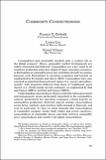| dc.contributor.author | Diebold, Francis X., 1959- | |
| dc.contributor.author | Liu, Laura | |
| dc.contributor.author | Yilmaz, Kamil | |
| dc.date.accessioned | 2019-11-01T00:08:15Z | |
| dc.date.available | 2019-11-01T00:08:15Z | |
| dc.date.issued | 2018 | |
| dc.identifier.isbn | 978-956-7421-58-9 | |
| dc.identifier.uri | https://hdl.handle.net/20.500.12580/3859 | |
| dc.description | Commodities and commodity markets play a central role in the global economy. Hence commodity market developments are widely chronicled and followed. Commodities are a key input to all countries’ production and a key output of many emerging economies so fluctuations in commodity prices may contribute strongly to common business cycle fluctuations in emerging economies and beyond as emphasized by Fernández and others (2015). Commodities have also emerged as important financial asset classes (e.g. energy agriculture metals) with properties different from those of 'traditional' asset classes (e.g. stocks bonds foreign exchange) as emphasized by Kat and Oomen (2007a) and Kat and Oomen (2007b). | |
| dc.format | .pdf | |
| dc.format.extent | Sección o Parte de un Documento | |
| dc.format.medium | p. 97-136 | |
| dc.language.iso | eng | |
| dc.publisher | Banco Central de Chile | |
| dc.relation.ispartof | Series on Central Banking Analysis and Economic Policies no. 25 | |
| dc.rights | Attribution-NonCommercial-NoDerivs 3.0 Chile | * |
| dc.rights.uri | http://creativecommons.org/licenses/by-nc-nd/3.0/cl/ | * |
| dc.subject | PRODUCTOS BÁSICOS | es_ES |
| dc.subject | MATERIAS PRIMAS | es_ES |
| dc.subject | PRECIOS | es_ES |
| dc.title | Commodity connectedness | |
| dc.type.doc | Artículo | |
| dc.file.name | BCCh-sbc-v25-p097_136 | |


